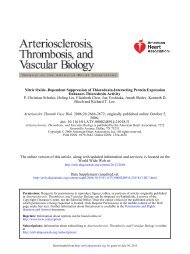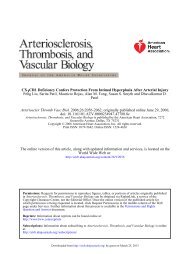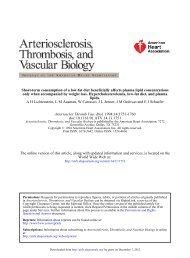Oral Presentations - Arteriosclerosis, Thrombosis, and Vascular ...
Oral Presentations - Arteriosclerosis, Thrombosis, and Vascular ...
Oral Presentations - Arteriosclerosis, Thrombosis, and Vascular ...
Create successful ePaper yourself
Turn your PDF publications into a flip-book with our unique Google optimized e-Paper software.
P47<br />
Effect of Adenosine A 1 Receptor Agonist R-Phenylisopropyladenosine on<br />
Left Ventricular Function <strong>and</strong> Heart Rate in Rats<br />
Guo Jin-Ai, Dai Cheng-Xian, Jing Chen. No. 466 Hospital of People’s Liberation Army,<br />
Beijing, China<br />
Objective To determine the regulative effects of adenosine A 1 receptor agonist<br />
R-phenylisopropyladenosine(R-PIA) on the heart rate(HR) <strong>and</strong> left ventricular function in rats.<br />
Methods Forty male Wistar rats were r<strong>and</strong>omly divided into five groups (n8 ): Group normal<br />
saline; Group R-PIA 0.03mg/kg; Group R-PIA 0.04mg/kg; Group R-PIA 0.05mg/kg; Group R-PIA<br />
0.03mg/kg plus DPCPX (an adenosine A 1 receptor antagonist) 0.2mg/kg. After being anesthetized,<br />
rats were inserted plastic cannula into left ventricular (LV) cavity through carotid artery<br />
,<strong>and</strong> the hemodynamics indexes of LV were continuously monitored <strong>and</strong> processed by Cardio2<br />
pressure signal processing software. At different point before <strong>and</strong> after subcutaneous<br />
administration of the drugs , the parameters of HR , LV-PSP, LV-DP, dp/dt max <strong>and</strong> RPP were<br />
recorded . The data were processed by SPSS 8.0 statistics analysis software . Results 1) A<br />
dose-dependent negative chronotropic effect on the heart was produced by R-PIA in<br />
anaesthetized rats; The decrease of HR was started from 5 min after R-PIA subcutaneous<br />
injection <strong>and</strong> got the lowest value during 15–30 min after administration of R-PIA . The effect<br />
of R-PIA on HR gradually disappeared during 90–120 min . 2) The temporary inhibition of LV<br />
function induced by R-PIA went to maximum during 15–30 min <strong>and</strong> tended to weaken at 60<br />
min after administration of the drug . 3) The RPP, an index reflecting myocardial oxygen<br />
requirement, was significantly reduced by R-PIA. Conclusions 1) This study validated again<br />
that adenosine A 1 receptor agonist R-PIA could bring on a dose-dependent negative<br />
chronotropic effect <strong>and</strong> negative inotropic effect on the heart of rat. 2) R-PIA’s effect of<br />
reducing myocardial oxygen requirement could last for a longer time than its negative inotropic<br />
effect, <strong>and</strong> those could be of much benefit to myocardial protection induced by R-PIA.<br />
Increased Levels of LDL Oxidation in Patients with Familial<br />
Hypercholesterolemia <strong>and</strong> in End-Stage Renal Disease Patients on<br />
Hemodialysis<br />
Lambertus J Van Tits, Jacqueline De Graaf, Sebastian J Bredie, Pierre N Demacker, Paul<br />
Holvoet, Anton F Stalenhoef. University Medical Center Nijmegen, Nijmegen, Netherl<strong>and</strong>s;<br />
Catholic University of Leuven, Leuven, Belgium<br />
Patients with familial hypercholesterolemia (FH) <strong>and</strong> patients with end-stage renal disease<br />
(ESRD) undergoing dialysis suffer from accelerated atherosclerosis. Oxidation of LDL is crucial<br />
in atherogenesis. Objectives: In the present study, we determined LDL oxidation level of<br />
isolated LDL of 11 male patients with FH, 15 male ESRD patients on hemodialysis, <strong>and</strong> 15<br />
age-matched male normolipidemic healthy controls. FH patients were without lipid-lowering<br />
medication for at least 4 weeks <strong>and</strong> were reassessed after two-year cholesterol-lowering<br />
therapy with statins. Methods: LDL oxidation level was measured by ELISA using monoclonal<br />
antibody 4E6 to oxidized LDL (oxLDL) as the capture antibody, <strong>and</strong> anti-human apoB antibody<br />
for detection, <strong>and</strong> expressed as percentage oxLDL. Findings: In FH patients <strong>and</strong> in ESRD<br />
patients on hemodialysis, plasma LDL oxidation levels were significantly elevated compared to<br />
controls (4.9 1.3; 3.7 2.0; 1.7 0.6%, respectively). Within each group of subjects, LDL<br />
oxidation level was not associated with history of CVD nor with smoking. Furthermore, in<br />
neither group a significant correlation was found between plasma concentration of LDL<br />
cholesterol <strong>and</strong> LDL oxidation level. After cholesterol-lowering therapy, LDL oxidation level in<br />
FH patients had not changed significantly <strong>and</strong> remained elevated compared to controls, despite<br />
a reduction of LDL cholesterol by 55% on the average. Also absolute plasma oxLDL<br />
concentrations, obtained by multiplying LDL oxidation level with plasma LDL cholesterol<br />
concentration, were significantly higher in FH patients before <strong>and</strong> after cholesterol-lowering<br />
therapy <strong>and</strong> in ESRD patients on hemodialysis than in controls (489 145; 189 122; 100 <br />
65; 59 27 moles/L, respectively). Conclusion: In conclusion, we show that both in FH<br />
patients <strong>and</strong> in ESRD patients on hemodialysis, oxidation level of circulating LDL is increased,<br />
<strong>and</strong> that cholesterol-lowering therapy with statins does not normalize elevated LDL oxidation<br />
levels in FH patients. Increased LDL oxidation levels might be involved in accelerated<br />
atherosclerosis in FH <strong>and</strong> in ESRD.<br />
Interaction of Aggregated LDL with Cultured Human Coronary Artery<br />
Endothelial Cells<br />
Bin Zhao, Wei Huang, Wei-Yang Zhang, Howard S Kruth. Section of Experimental<br />
Atherosclerosis, NHLBI, NIH, Bethesda, MD<br />
OBJECTIVE: It is known that macrophages take up aggregated LDL (AgLDL), a form of LDL<br />
found in atherosclerotic lesions. The purpose of the present investigation was to determine<br />
whether cultured human coronary artery endothelial cells (HCAEC) also interact with AgLDL.<br />
RESULTS: Both human monocyte-macrophages <strong>and</strong> HCAEC showed cell-association of LDL<br />
aggregated by treatment with sphingomyelinase. After incubation with 50 ug/ml 125I-AgLDL for<br />
1 day, cell-associated 125I-AgLDL was 394 <strong>and</strong> 455 ug/mg cell protein for macrophages<br />
<strong>and</strong> HCAEC, respectively. When incubated with 50 ug/ml 125I-LDL, macrophages <strong>and</strong> HCAEC<br />
showed very low levels of cell-associated 125I-LDL, 0.40 <strong>and</strong> 2.10.3 ug/mg, respectively.<br />
Interestingly, the microtubule inhibitor, nocodazole, decreased HCAEC cell-associated 125I- AgLDL by 52%, but did not decrease macrophage cell-associated 125I-AgLDL. Degradation of<br />
125 125 125 I-AgLDL (i.e., medium TCA-soluble I) compared with I-LDL was increased 37-fold (from<br />
20 to745 ug/mg) in macrophages, but wasDownloaded not increased forfrom HCAEC (131 <strong>and</strong> 111<br />
Poster <strong>Presentations</strong><br />
P48<br />
P49<br />
http://atvb.ahajournals.org/<br />
Poster <strong>Presentations</strong> a-9<br />
ug/mg). Thus, macrophages <strong>and</strong> HCAEC degraded 65% <strong>and</strong> 22% of the total accumulated<br />
125 I-AgLDL (cell-associated degraded), respectively. In contrast to cell-associated 125 I-<br />
AgLDL, nocodazole decreased 125 I-AgLDL degradation in macrophages by 38% (from 745 to<br />
464 ug/mg), but did not affect 125 I-AgLDL degradation in HCAEC. This means that although<br />
both macrophages <strong>and</strong> HCAEC can take up <strong>and</strong> degrade AgLDL, microtubules functioned<br />
differently in this process for each cell type. Examination of HCAEC cultures by phase<br />
microscopy showed that AgLDL was bound to the surface of some but not all cells. Some<br />
HCAEC strains showed low levels of cell-associated 125 I-AgLDL <strong>and</strong> these same cell strains<br />
showed very few endothelial cells that bound AgLDL. CONCLUSIONS: HCAEC process AgLDL<br />
differently than macrophages by showing relatively high levels of 125 I-AgLDL cell-association<br />
that was nocodazole-sensitive, but low levels of 125 I-AgLDL degradation, which was<br />
nocodazole-resistant. In addition, HCAEC strains show cell to cell <strong>and</strong> strain to strain<br />
heterogeneity in their interaction with AgLDL.<br />
Lipoprotein Lipid Loading <strong>and</strong> Cytokine Response in Macrophages<br />
Marie Lindholm, Jenny Persson, Jan Nilsson. Lund University, Malmö, Sweden<br />
It is well established that macrophage uptake of modified LDL results in foam cell formation,<br />
cytokine signaling <strong>and</strong> most probably propagation of atherosclerotic plaques. However, massive<br />
lipid droplet formation <strong>and</strong> a foam cell like appearance may also be caused by incubation of<br />
macrophages with other lipoproteins. The main objective of the current study has been to study<br />
how such lipid loading affect macrophage inflammatory response. Human monocyte-derived<br />
macrophages have been pre-incubated with fresh LDL, vortex-aggregated LDL (AgLDL) or<br />
VLDL, which increase intracellular cholesterol esters or triglycerides, respectively. Cells were<br />
differentiated for five days before commencing the experiment, then pre-treated with<br />
respective lipoprotein for 16 h. Cells were incubated for 4 h with fresh media with or without<br />
TNF- .Cytokine concentrations have been measured in conditioned media <strong>and</strong> lipid content in<br />
the cells (n10). It appears as if the lipoproteins have differential effects on both basal <strong>and</strong><br />
stimulated cytokine secretion. Pre-treatment with VLDL increase basal secretion of IL-1 with<br />
230% compared to control, <strong>and</strong> decrease secretion of TNF- by 57% <strong>and</strong> IL-8 by 70%. AgLDL<br />
have a less pronounced but similar pattern of effects on cytokine secretion (160, 51 <strong>and</strong> 50%,<br />
respectively), as does native LDL (70, 44 <strong>and</strong> 50%, respectively). The cells were also stimulated<br />
with TNF- after pre-incubations with lipoproteins. VLDL-treatment decreased stimulated IL-8<br />
secretion by 32% compared to control, whereas LDL <strong>and</strong> AgLDL had mild increasing effects.<br />
In contrast, AgLDL had a strong enhancing effect on stimulated IL-1 secretion (80% more<br />
than control) compared to LDL <strong>and</strong> VLDL (8 <strong>and</strong> 40%). In conclusion, it appears as if LDL,<br />
AgLDL <strong>and</strong> in particular VLDL have specific effects on basal <strong>and</strong> cytokine-stimulated<br />
macrophage inflammatory signals in vitro. This is of interest as VLDL clearance is slow in<br />
diabetic patients <strong>and</strong> it has long been recognized that this may be causative to the increased<br />
risk for atherosclerosis in these individuals.<br />
P51<br />
Overexpression of Antioxidant Enzymes Reduces OxLDL-Induced Monocyte<br />
Adhesion to Mouse Endothelial Cells<br />
Zhongmao Guo, Hong Yang, Felicia Rymundo, Arlan Richardson. Meharry Medical College,<br />
Nashville, TN; University of TX Health Science Center at San Antonio, San Antonio, TX<br />
Adhesion of monocytes to endothelium plays a critical role in atherogenesis. In the present<br />
study, we determined the effect of overexpressing antioxidant enzymes on the adhesion of<br />
monocytes to endothelial cells (EC) <strong>and</strong> the expression of EC adhesion molecules. ECs were<br />
obtained from the aorta of wild-type mice <strong>and</strong> transgenic mice overexpressing Cu/Znsuperoxide<br />
dismutase (SOD), catalase or both Cu/Zn-SOD <strong>and</strong> catalase. The ECs were<br />
incubated with native LDL, CuSO4-oxidized low-density lipoprotein (oxLDL) or culture medium<br />
alone (control) for 2 hours <strong>and</strong> then incubated with mouse monocytes for 1 hour. Adhesion of<br />
monocytes to ECs was determined by measuring the myeloperoxidase activity or the number<br />
of monocytes firmly attached to ECs. The expression of EC adhesion molecules was determined<br />
by measuring the protein level of vascular cell adhesion molecule 1 (VCAM-1) <strong>and</strong> monocyte<br />
chemotactic protein 1 (MCP-1) after the ECs were incubated with native LDL, oxLDL or culture<br />
medium alone. Results from this study showed that oxLDL significantly increased monocyte<br />
adhesion to ECs <strong>and</strong> significantly increased the protein level of VCAM-1 <strong>and</strong> MCP-1 in ECs,<br />
overexpression of antioxidant enzymes significantly reduced oxLDL-induced monocyte adhesion<br />
to ECs <strong>and</strong> significantly reduced the level of EC adhesion molecules. For example, after<br />
ECs were treated with oxLDL, the number of monocytes attached to the ECs obtained from<br />
transgenic mice overexpressing Cu/Zn-SOD, catalase or both Cu/Zn-SOD <strong>and</strong> catalase was<br />
50%, 30% <strong>and</strong> 70% less, respectively as compared to that attached to ECs obtained from<br />
wild-type mice. The protein level of VCAM-1 <strong>and</strong> MCP-1 in ECs obtained from mice<br />
overexpressing Cu/Zn-SOD <strong>and</strong>/or catalase was significantly lower than that in ECs obtained<br />
from wild-type mice. These results suggest that reactive oxygen species, such as superoxide<br />
<strong>and</strong> hydrogen peroxide, play a role in oxLDL-induced monocyte adhesion to ECs. This work is<br />
supportedby in part guest by AHA on grant April 0030239N 4, 2013<strong>and</strong><br />
NIH grant 1P30AG13319.<br />
P50














